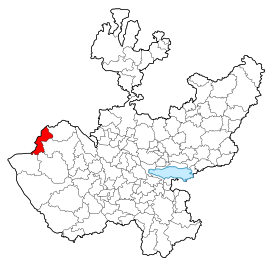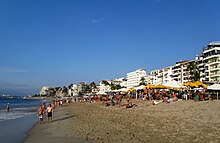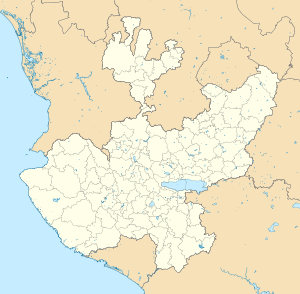
A | B | C | D | E | F | G | H | CH | I | J | K | L | M | N | O | P | Q | R | S | T | U | V | W | X | Y | Z | 0 | 1 | 2 | 3 | 4 | 5 | 6 | 7 | 8 | 9
Puerto Vallarta | |
|---|---|
 Above, from left to right: Panoramic view of Villa del Palmar, Our Lady of Guadalupe Parish, the Sea Horse Sculpture, the pier, view of the hotel zone from the boardwalk, Marina Vallarta and downtown. | |
| Nickname(s): P.V., Vallarta | |
 Location of the municipality within the state of Jalisco | |
| Coordinates: 20°38′45″N 105°13′20″W / 20.64583°N 105.22222°W | |
| Country | Mexico |
| State | Jalisco |
| Municipality | Puerto Vallarta |
| Founded | December 12, 1851 |
| Founded as | Las Peñas |
| Named for | Ignacio Vallarta |
| Government | |
| • Municipal president | Luis Alberto Michel Rodríguez ( |
| Area | |
| • City | 49.11 km2 (18.96 sq mi) |
| • Metro | 1,452 km2 (561 sq mi) |
| • Municipality | 680.9 km2 (262.9 sq mi) |
| Elevation | 7 m (23 ft) |
| Population | |
| • City | 224,166 |
| • Density | 4,600/km2 (12,000/sq mi) |
| • Metro | 479,471 |
| • Metro density | 330/km2 (860/sq mi) |
| • Municipality | 291,839 |
| • Municipality density | 430/km2 (1,100/sq mi) |
| Demonym | Vallartense |
| Time zone | UTC−6 (Central Central Standard Time) |
| • Summer (DST) | UTC−6 (Central Standard Time) |
| Postal code | 48300 |
| Area code | +52 322 |
| Website | puertovallarta |
Puerto Vallarta (Spanish pronunciation: [ˈpweɾto βaˈʎaɾta] or simply Vallarta) is a Mexican beach resort city on the Pacific Ocean's Bahía de Banderas in the Mexican state of Jalisco. Puerto Vallarta is the second largest urban agglomeration in the state after the Guadalajara Metropolitan Area. The City of Puerto Vallarta is the government seat of the Municipality of Puerto Vallarta, which comprises the city as well as population centers outside of the city extending from Boca de Tomatlán to the Nayarit border (the Ameca River). The city is located at 20°40′N 105°16′W / 20.667°N 105.267°W. The municipality has an area of 681 square kilometres (262.9 sq mi). To the north, it borders the southwest of the state of Nayarit. To the east, it borders the municipality of Mascota and San Sebastián del Oeste, and to the south, it borders the municipalities of Talpa de Allende and Cabo Corrientes.[4]
Puerto Vallarta is named after Ignacio Vallarta, a former governor of Jalisco. In Spanish, Puerto Vallarta is frequently shortened to "Vallarta", while English speakers call the city P.V. for short. In Internet shorthand, the city is often referred to as PVR, after the International Air Transport Association airport code for its Gustavo Diaz Ordaz International Airport.
History
Playa Los Muertos (Beach of the Dead)
In the 16th century, Hernán Cortés explored the Pacific side of Mexico by ship. Cortés used the established port of Acapulco to resupply and anchor his ships along the journey. During the early 1500s, he sent two of his ships North to explore the coastline without him. One of his ships wrecked in Banderas Bay and all but three men were reportedly killed. It is believed the corpses of the lost sailors washed ashore. Native villagers encountered numerous corpses on the beach for days after the wreck.[5]
Bahía de Banderas (Bay of Flags)
Pirates were known to attack ships along the Pacific Coast of Mexico as early as the 16th century. In the early 1500s the famous explorer Hernán Cortés set out to establish a safe harbor, north of Acapulco, to provide protection for cargo ships sailing the planned Manila galleon trade route to the Philippines. Just several hundred miles north, he discovered a large bay at the village of Tintoque. According to local legend, pirates were already anchoring in this bay and regularly pillaged local villagers while burying treasure in the hills. When Cortes and his crew set foot on the beach, a mob of angry villagers believed he and his crew were pirates and surrounded them with native weapons in hand. According to his journal, a Catholic friar accompanying the crew began praying to the Lord for help. Villagers were mesmerized by the red flags the crew carried and suddenly lowered their weapons, allowing the explorers to pass peacefully. It's likely the villagers had seen the flags before when they floated ashore with the dead crew from a Cortés ship that wrecked earlier in the bay. This is how the Bahía de Banderas was named. Francisco Cortés de Buenaventura, the nephew of Hernán Cortés, is said to have formalized the bay's name during his own conquering of the region in 1525. In the following years, Tintoque became a major port and safe harbor for ships traveling the Manila galleon.[6][7]
Pre-Hispanic times to the 19th century
Few details are known about the history of the area prior to the 19th century. There is archaeological evidence to suggest continuous human habitation from 580 BC, and similar evidence (from sites near Ixtapa and in Col. Lázaro Cárdenas)[8] that the area belonged to the Aztlán culture which dominated Jalisco, Nayarit and Michoacán from c. 900–1200. The limited evidence in occidental Mexican archeology have limited the current knowledge about pre-historic life in the area.[9]
El Carrizal and Las Peñas – 19th century
The official founding story of Las Peñas and thus of Puerto Vallarta is that it was founded by Guadalupe Sánchez Torres, his wife Ambrosia Carrillo and some friends such as Cenobio Joya, Apolonio de Robles, Cleofas Peña and Martín Andrade, among others, on December 12, 1851, and was given the name of Las Peñas de Santa María de Guadalupe since it was the day dedicated to the virgin of Guadalupe. Although the purchase record of the property by Guadalupe Sanchez is dated 1859, his family lived there prior to the purchase year.[10][11]
There is however no doubt the development of Las Peñas into a self-sustaining village of any significant size happened in the 1860s as the mouth of the Cuale area was exploited to support the operations of the newly enfranchised Union en Cuale company. As such 1859 marks the beginning of Puerto Vallarta as a village. Twenty years later, by 1885, the village comprised about 250 homes and about 800 residents.[12]
The modern resort – 20th century to present

The Mexican government invested significantly in transportation improvements, making Puerto Vallarta an easy travel destination. To make Puerto Vallarta accessible by jet aircraft the government developed the city's international airport. Ground transportation significantly improved. Government invested heavily in the development of highway and utility infrastructure. Another vital improvement for the city was the El Salado wharf (where the current cruise terminal is), inaugurated on June 1, 1970, making Puerto Vallarta Jalisco's first harbor town.[13]
During the mid-1980s, Puerto Vallarta experienced a rapid expansion of impromptu communities poorly served by even basic public services. This very low standard of living leveled out Puerto Vallarta's resort boom. In the late 1980s Puerto Vallarta's government worked to alleviate the situation by developing housing and infrastructure. But the legacy of the 1980s boom remains, as the outlying areas of Puerto Vallarta suffer from poor provision of basic services (i.e. water, sewage, roads).[14]
Geography

Puerto Vallarta lies on a narrow coastal plain at the foot of the Sierras Cuale and San Sebastián, parts of the Sierra Madre Occidental. The plain widens to the north, reaching its widest point along the Ameca river. Three rivers flow from the Sierra through the area. From south to north they are the Cuale, the Pitillal, and the Ameca. A number of arroyos also run from the Sierra to the coastal plain. Many of the valleys of these rivers and arroyos are inhabited. Also development has to some extent spread up the hillsides from the coastal plain.
The city proper comprises four main areas: the hotel zone along the shore to the north, Olas Altas – Colonia Emiliano Zapata to the south of the Cuale river (recently named Zona Romántica in some tourist brochures), the Centro along the shore between these two areas, and a number of residential areas to the east of the hotel zone. The oldest section of the town is the area of Col. Centro near the church of Our Lady of Guadalupe, especially Hidalgo street.
Seismic history
Puerto Vallarta, like much of the west coast of North America, is prone to earthquakes, though Puerto Vallarta tends to experience only peripheral effects of earthquakes centered farther south. On 9 October 1995, an earthquake located off the Colima coast shook the crown from the top of the Roman Catholic Church.[15][16]
Climate
Puerto Vallarta has a Tropical wet and dry climate (Köppen climate classification Aw), with dry winters and rainy summers.[17] The average daily high temperature is 86 °F (30 °C); average daily low temperature is 70 °F (21 °C); average daily humidity is 75%. The rainy season extends from mid June through mid October, with most of the rain between July and September. August is the city's wettest month, with an average of 14 days with significant precipitation. Even during the rainy season precipitation tends to be concentrated in large rainstorms. Occasional tropical storms will bring thunderstorms to the city in November, though the month is typically dry. There is a marked dry season in the winter. February, March and April are the months with the least cloud cover.[18]
Hurricanes seldom strike Puerto Vallarta. In 2002, Hurricane Kenna, a category 5 hurricane, made landfall about 160 km (100 mi) northwest of Puerto Vallarta, and the city suffered some damage from the resulting storm surge. In 1971, Hurricane Lily, a category 1 hurricane, caused serious flooding on the Isla Cuale, prompting the city to relocate all of its residents to the new Colonia Palo Seco.
| Climate data for Puerto Vallarta, Jalisco, Mexico | |||||||||||||
|---|---|---|---|---|---|---|---|---|---|---|---|---|---|
| Month | Jan | Feb | Mar | Apr | May | Jun | Jul | Aug | Sep | Oct | Nov | Dec | Year |
| Record high °C (°F) | 35.0 (95.0) |
35.0 (95.0) |
36.0 (96.8) |
36.0 (96.8) |
43.5 (110.3) |
45.0 (113.0) |
45.0 (113.0) |
39.0 (102.2) |
38.0 (100.4) |
39.0 (102.2) |
37.0 (98.6) |
36.0 (96.8) |
45.0 (113.0) |
| Mean daily maximum °C (°F) | 26.7 (80.1) |
26.7 (80.1) |
27.2 (81.0) |
27.8 (82.0) |
29.4 (84.9) |
31.7 (89.1) |
32.2 (90.0) |
32.2 (90.0) |
32.2 (90.0) |
31.7 (89.1) |
30.0 (86.0) |
27.8 (82.0) |
29.6 (85.4) |
| Daily mean °C (°F) | 21.7 (71.1) |
21.7 (71.1) |
22.2 (72.0) |
23.6 (74.5) |
25.6 (78.1) |
28.3 (82.9) |
28.6 (83.5) |
28.3 (82.9) |
28.3 (82.9) |
27.8 (82.0) |
25.3 (77.5) |
22.8 (73.0) |
25.4 (77.6) |
| Mean daily minimum °C (°F) | 16.7 (62.1) |
16.7 (62.1) |
17.2 (63.0) |
18.9 (66.0) |
21.7 (71.1) |
25.0 (77.0) |
25.0 (77.0) |
24.4 (75.9) |
24.4 (75.9) |
23.9 (75.0) |
20.6 (69.1) |
17.8 (64.0) |
21.0 (69.9) |
| Record low °C (°F) | 11 (52) |
8 (46) |
12 (54) |
11 (52) |
11 (52) |
17 (63) |
21 (70) |
21 (70) |
18 (64) |
16 (61) |
13 (55) |
7 (45) |
7 (45) |
| Average rainfall mm (inches) | 33.8 (1.33) |
5.3 (0.21) |
2.0 (0.08) |
1.5 (0.06) |
15.4 (0.61) |
187.6 (7.39) |
328.1 (12.92) |
312.4 (12.30) |
370.0 (14.57) |
93.8 (3.69) |
19.8 (0.78) |
22.5 (0.89) |
1,392.2 (54.83) |
| Average rainy days (≥ 0.1 mm) | 2.2 | 0.7 | 0.6 | 0.2 | 1.0 | 10.8 | 16.4 | 15.2 | 15.6 | 5.1 | 1.4 | 1.9 | 71.1 |
| Average relative humidity (%) | 67 | 65 | 65 | 67 | 68 | 69 | 69 | 70 | 70 | 68 | 67 | 68 | 68 |
| Source 1: World Meteorological Organization.[19] | |||||||||||||
| Source 2: Weatherbase[20] | |||||||||||||
| Jan | Feb | Mar | Apr | May | Jun | Jul | Aug | Sep | Oct | Nov | Dec |
|---|---|---|---|---|---|---|---|---|---|---|---|
| 24 °C (75 °F) | 24 °C (75 °F) | 24 °C (75 °F) | 25 °C (77 °F) | 27 °C (81 °F) | 28 °C (82 °F) | 29 °C (84 °F) | 30 °C (86 °F) | 30 °C (86 °F) | 30 °C (86 °F) | 28 °C (82 °F) | 25 °C (77 °F) |
Hurricane Patricia
Hurricane Patricia, a Category 5 storm, became the most powerful cyclone ever measured in the Western Hemisphere with sustained wind speeds up to 200 mph (320 km/h). Hurricane Patricia was forecast to make landfall at Puerto Vallarta on the evening of October 23, 2015, with catastrophic damage predicted for the town and surrounding areas and the potential for mud slides. The storm changed from a Category 1 to a Category 5 in just 24 hours, thus catching some vacationers off guard and leaving many trapped in the town. The Jalisco state government put together 30 buses to evacuate tourists from the coast to Guadalajara, a 5-hour ride inland. Manzanillo, Colima was also near the forecast catastrophic damage zone. Ultimately, Patricia made landfall south of Puerto Vallarta, sparing the city from any significant damage.[22][23]
Economy
Nearly 80% of the workforce is employed in tourist related industries: hotels, restaurants, personal services, and transportation.[24]
Tourism trends

Tourism in Puerto Vallarta has increased steadily over the years and makes up 80% of the city's economic activity in 2020.[24] The high season for international tourism in Puerto Vallarta is from late November through March (or later, depending on the timing of the college spring break period in the U.S. The city is especially popular with U.S. residents from the southern and western U.S. because of the number of direct flights between Puerto Vallarta and Atlanta, Los Angeles, San Francisco, Seattle, Denver, Phoenix, Dallas/Fort Worth, Houston, Minneapolis/St Paul and Chicago.[25]
Real estate tourism

Puerto Vallarta has become a popular retirement destination for U.S. and Canadian retirees. This has created a number of neighborhoods within the Puerto Vallarta region that cater primarily to real estate tourism, such as the Hotel Zone, which stretches from downtown Vallarta to the airport and Marina Vallarta (near the airport), and Amapas and Conchas Chinas, which are built into the mountain slightly south and behind Puerto Vallarta, and overlook the city and bay. Most recently the downtown area, especially in Emiliano Zapata (also known as the Romantic Zone), has seen a somewhat controversial trend of traditional homes being razed for the construction of condominium buildings. This region in recent years has been the most popular for Vallarta real estate tourism, with nearly 25% of all real estate sales for the region taking place there in 2019.[26]

The Vallarta tourism real estate tourism market is made up of both full-time retirees and a second-home owners, primarily from the United States. On average about 40% of buyers are American, with Mexican nationals consisting of 30% and Canadians and other foreign buyers making up the remaining 20%. Mexicans favor destinations such as Puerto Vallarta, Los Cabos and Cancún not just for the sun and beach, but also as real estate investment to hedge their pesos as real estate in these regions is priced in USD, rather than in pesos like the rest of the country.[26]
Puerto Vallarta can be classified as a medium-ranged real estate market with a market consisting mostly of condominiums with the average price around US$320,000 in 2019.[26] Any foreigner wishing to buy real estate in Puerto Vallarta (or anywhere along the coast of Mexico), can't own real estate there outright, but needs to establish a fideicommissum or beneficial trust which is held with a Mexican bank on the owner's behalf. It is not the same as holding the title. The trust is good for 50 years and can be renewed for another 50-year period.[27]
LGBT tourism

Puerto Vallarta has developed into Mexico's premier resort town as a sort of satellite gay space for its big sister Guadalajara, much as Fire Island is to New York City and Palm Springs is to Los Angeles.[28] It is now considered the most welcoming and gay-friendly destination in the country, dubbed the "San Francisco of Mexico."[29] Previously quite conservative, the municipal government has become increasingly supportive in recognising and accepting the LGBT tourism segment and supporting LGBT events such as Vallarta gay pride celebrations, which launched in 2013 and are now held annually to coincide with U.S. Memorial Day weekend.[30] It boasts a gay scene, centered in the city's south-side Zona Romántica, of hotels and resorts as well as many bars, nightclubs and a gay beach on the main shore.[29] Puerto Vallarta has been cited as the number one gay beach destination in Latin America,[31] with city officials claiming a 5% tourism increase in 2013.[32]
Population and growth rate for Puerto Vallarta
The major suburb is Bahia de Banderas in Nayarit across state lines, in which Nuevo Vallarta and Sayulita are localities. Ixtapa is a locality in PV, not to be confused with the municipality of Ixtapa in Guerrero state.




